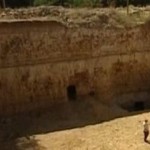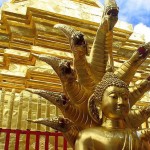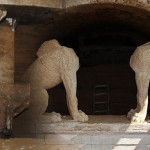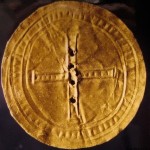Strange Skeleton with ‘Alien’ Elongated Skull Found at Russia’s Stonehenge
A skeleton with an unusual-shaped skull has been unearthed on a site known as Russia’s Stonehenge, Arkaim, near Chelyabinsk in central Russia - a settlement dating back almost 4,000 years.
Arkaim (Russian: Аркаим) is an archaeological site situated in the Southern Urals steppe, 8.2 kilometres (5.1 mi) north-to-northwest of the village of Amurskiy and 2.3 km (1.4 mi) south-to-southeast of the village of Alexandrovskiy, in the Chelyabinsk Oblast, Russia, just to the north from the Kazakhstan border.
The site is generally dated to the 17th century BC. Earlier dates, up to the 20th century BC, have been proposed. It was a settlement of the Sintashta-Petrovkaculture.
The site was discovered in 1987 by a team of Chelyabinsk scientists who were preparing the area to be flooded in order to create a reservoir, and examined in rescue excavations led by Gennadii Zdanovich. At first their findings were ignored by Soviet authorities, who planned to flood the site as they had flooded Sarkelearlier, but the attention attracted by news of the discovery forced the Soviet government to revoke its plans for flooding the area. It was designated a cultural reservation in 1991, and in May 2005 the site was visited by President Vladimir Putin.
Watch the Video for more about the Alien Skull:
Although the settlement was burned and abandoned, much detail is preserved. Arkaim is similar in form but much better preserved than neighbouring Sintashta, where the earliest chariot was unearthed. The site was protected by two circular walls. There was a central square, surrounded by two circles of dwellings separated by a street. The settlement covered ca. 20,000 m2 (220,000 sq ft). The diameter of the enclosing wall was 160 m (520 ft). It was built from earth packed into timber frames, and reinforced with unburned clay brick, with a thickness of 4–5 m (13–16 ft). and a height of 5.5 m (18 ft). The settlement was surrounded with a 2 m (6 ft 7 in)-deep moat.
There are four entrances into the settlement through the outer and inner wall with the main entrance to the west. The dwellings were between 110–180 m2 (1,200–1,900 sq ft) in area. The outer ring of dwellings number 39 or 40, with entrances to a circular street in the middle of the settlement. The inner ring of dwellings number 27, arranged along the inner wall, with doors to the central square of 25 by 27 m (82 by 89 ft). The central street was drained by a covered channel. Zdanovich estimates that approximately 1,500 to 2,500 people could have lived in the settlement.
Surrounding Arkaim’s walls, were arable fields, 130–140 m by 45 m (430–460 ft by 150 ft), irrigated by a system of canals and ditches. Remains of millet and barleyseeds were found.
The 17th century BC date suggests that the settlement was about co-eval to, or just post-dating, the Indo-Aryan migration into South Asia and Mesopotamia (theGandhara grave culture appearing in the Northern Pakistan from ca. 1600 BC, the Indo-European Mitanni rulers reached Anatolia before 1500 BC, both roughly 3,000 kilometres (1,900 mi) removed from the Sintashta-Petrovka area), and that it was either an early Iranian culture, or an unknown branch of Indo-Iranian that did not survive into historical times.






